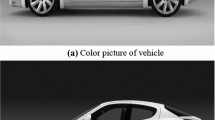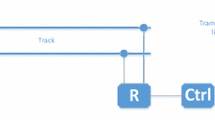Abstract
In order to improve the recognition effect of road condition of railway transportation and improve the safety of railway transportation, this paper combines artificial intelligence recognition technology to improve the algorithm, and applies Minkowski distance and dynamic time warping distance to the evaluation of the accuracy of tram track recognition. Moreover, this paper introduces the mean value and variance of the distance between track points as auxiliary evaluation indicators, establishes the evaluation indicators for the accuracy of tram track recognition, and proposes a road condition of railway transportation judgment system based on artificial intelligence recognition technology. In addition, this paper installs a high-definition camera and a visible light sensor on the head of the train to analyze and process the collected smart video and visible light images respectively. Finally, this paper verifies the system of this paper through experimental research. From the experimental research, it can be seen that the system constructed in this paper can effectively improve the effect of road condition of railway transportation recognition.









Similar content being viewed by others
References
Banić M, Miltenović A, Pavlović M et al (2019) Intelligent machine vision based railway infrastructure inspection and monitoring using UAV[J]. Facta Univ, Series: Mech Eng 17(3):357–364
Bin Osman MH, Kaewunruen S, Jack A (2018) Optimisation of schedules for the inspection of railway tracks[J]. Proc Inst Mech Eng, Part f: J Rail Rapid Transit 232(6):1577–1587
Falamarzi A, Moridpour S, Nazem M (2019) A review on existing sensors and devices for inspecting railway infrastructure[J]. Jurnal Kejuruteraan 31(1):1–10
Han SH, Cho MS, Yu YK et al (2017) A study on cantilever deformation inspection method using image processing[J]. Trans Korean Inst Electr Eng 66(6):988–994
Krishna BR, Seshendra D, Raja GG et al (2017) Railway track fault detection system by using ir sensors and bluetooth technology[J]. As J Appl Sci Technol (AJAST) 1(6):82–84
Li P, Long Z, Yang Z (2020) RF energy harvesting for batteryless and maintenance-free condition monitoring of railway tracks[J]. IEEE Internet Things J 8(5):3512–3523
Li Y, Liu Z, Liu X et al (2019) High-speed electromagnetic train wheel inspection using a Kalman-model-based demodulation algorithm[J]. IEEE Sens J 19(16):6833–6843
Liu J, Huang Y, Zou Q et al (2019a) Learning visual similarity for inspecting defective railway fasteners[J]. IEEE Sens J 19(16):6844–6857
Liu S, Wang Q, Luo Y (2019b) A review of applications of visual inspection technology based on image processing in the railway industry[J]. Transp Saf Environ 1(3):185–204
Nan G, Gao Y (2018) Automated visual inspection of multipattern train components using gradient information and feature fusion under the illumination-variant condition[J]. Proc Inst Mech Eng, Part f: J Rail Rapid Transit 232(5):1500–1513
Rajamäki J, Vippola M, Nurmikolu A et al (2018) Limitations of eddy current inspection in railway rail evaluation[J]. Proc Inst Mech Eng, Part f: J of Rail Rapid Transit 232(1):121–129
Shen Y, Liu Z, Zhang G (2018) PAC interaction inspection using real-time contact point tracking[J]. IEEE Trans Instrum Meas 68(10):4051–4064
Tomiyama T, Sato T, Okada K et al (2018) Railway rollingrolling-stockock-assignmentassignment-scheduling algorithm for minimizing inspection cost[J]. IAENG Int J Appl Math 48(2):1–10
Torabi M, Mousavi GSM, Younesian D (2021) A new flexible laser beam profiler for the inspection of train wheels[J]. Proc Inst Mech Eng, Part f: J Rail Rapid Transit 235(2):215–225
Torabi M, Mousavi SGM, Younesian D (2018) A high accuracy imaging and measurement system for wheel diameter inspection of railroad vehicles[J]. IEEE Trans Industr Electron 65(10):8239–8249
Wang SM, Liao CL, Ni YQ (2020) A machine vision system based on driving recorder for automatic inspection of rail curvature[J]. IEEE Sens J 21(10):11291–11300
Xiao L, Wu B, Hu Y et al (2019) A hierarchical features-based model for freight train defect inspection[J]. IEEE Sens J 20(5):2671–2678
Ye J, Stewart E, Roberts C (2019) Use of a 3D model to improve the performance of laser-based railway track inspection[J]. Proc Inst Mech Eng, Part f: J Rail Rapid Transit 233(3):337–355
Zhang Z, Hou T (2018) Edge extraction of train wheel tread damage based on improved canny algorithm[J]. Railw Stand Des 62(1):148–150
Zhong J, Liu Z, Han Z et al (2018) A CNN-based defect inspection method for catenary split pins in high-speed railway[J]. IEEE Trans Instrum Meas 68(8):2849–2860
Zhou F, Song Y, Liu L et al (2018) Automated visual inspection of target parts for train safety based on deep learning[J]. IET Intel Transport Syst 12(6):550–555
Funding
There was no outside funding or grants received that assisted in this study.
Author information
Authors and Affiliations
Corresponding author
Ethics declarations
Conflict of interest
The author declared that they have no conflicts of interest to this work. I declare that I do not have any commercial or associative interest that represents a conflict of interest in connection with the work submitted.
Additional information
Publisher's Note
Springer Nature remains neutral with regard to jurisdictional claims in published maps and institutional affiliations.
Rights and permissions
About this article
Cite this article
Cao, L. Road condition judgment system of railway transportation based on artificial intelligence recognition technology. Int J Syst Assur Eng Manag 14, 718–727 (2023). https://doi.org/10.1007/s13198-021-01509-w
Received:
Revised:
Accepted:
Published:
Issue Date:
DOI: https://doi.org/10.1007/s13198-021-01509-w




